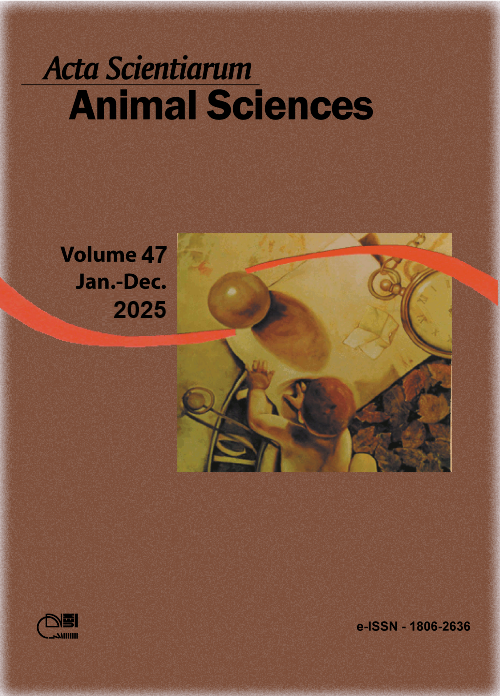Effects Effects of Breed and Sex on Performance and Blood Characteristics of Three Commercial Broiler Strains of Breed and Sex on Performance and Blood Characteristics of Three Commercial Broiler Strains Corresponding Author: Olawale Mojeed, Akanbi
Abstract
This study was conducted to compare three strains (Arbor Acre, Cobb and Marshal) of broiler chickens using growth traits and biochemical profile with the view of identifying the best strain in the broilers. The experiment was conducted to investigate the performance and blood characteristics of three commercial broiler strains. 288 day-old of Arbor acre, Cobb and Marshall strains were used comprised of 96 birds per strains on a 12 replicates with 8 birds in a Completely Randomized Design (CRD). The birds were sexed and tagged using a wing tag. All data generated were subjected to 2 by 3 factorial in completely randomized design (CRD). Least square means of body weights indicated that strains had significant (p < 0.05) effect on the birds with Cobb having the highest weights compared to Arbore acre and Marshall. Body linear measurement also showed significant (p < 0.05) effect on all parameters on both sex and strains. Female birds showed significantly (p < 0.05) different than the male on mean cell volume, mean corpuscular haemoglobin only while the strain effect was significant on all haematological parameters measured. Furthermore, serum biochemical indices revealed that there was significant (p < 0.05) influence on strain and sex was not significantly (p > 0.05) influenced. It was, therefore, concluded from the study that Cobb performed better than Arbor acre and Marshall strains at 6 weeks and could be a better strain to attain maturity at a shortest possible period.
Downloads
References
Addass, P. A., David, D. L., Edward, A., Zira, K. E., & Midau, A. (2012). Effect of Age, Sex and Management System on Some Haematological Parameters of Intensively and Semi-Intensively Kept Chicken in Mubi, Adamawa State, Nigeria. Iranian Journal of Applied Animal Science, 2, 277-282.
Agu, O. J., Ngambi, J. W., Norris, D., & Egena, S. S. A. (2012). Comparative study of three indigenous chicken breeds of South Africa for body weight and linear measurement. Agricultural Journal, 7(3), 220-225. https://doi.org/10.3923/aj.2012.220.225
Amao, S. R. (2017). Egg production and growth performance of naked neck and Rhode Island Red chickens under Southern Guinea Savanna condition of Nigeria. International Journal of Agriculture and Earth Science, 3(2), 1-10.
Chineke, C. A., Ologun, A. G., & Ikeobi, C. O. N. (2006): Haematological parameters in rabbit breeds and crosses in humid tropics, Pakistani Journal of Biological Science, 9(11), 2102-2106. https://doi.org/10.3923/pjbs.2006.2102.2106
Demeke, S. (2007). Suitability of hay-box brooding technology to rural household poultry production system. Livestock Research for Rural Development, 19(1), 347-354.
Donkoh, A. (1989). Ambient temperature: a factor affecting performance and physiological response of broiler chickens. International Journal of Biomet, 33(4), 259-265. https://doi.org/10.1007/BF01051087
Fassill, B., Adnoy, T., Gjoen, H. M., Kathl, J., & Abebe, G. (2010). Production performance of dual-purpose crosses of two indigenous with two exotic chicken breeds in Subtropical environment. International Journal of Poultry Science, 9(7), 702-710. https://doi.org/10.3923/ijps.2010.702.710
Haftu, K. S. (2016). Exotic Chicken Status, Production Performance and Constraints in Ethiopia: A Review. Asian Journal of Poultry Science, 10(1), 30-39. https://doi.org/10.3923/ajpsaj.2016.30.39
Iheukwumere, F. C., Abu, A. H., & Ameh, M. (2006). Effect of human menopausal gonadotropin on haematological and serum biochemical parameters of the Nigerian Indigenous chickens, International Journal of Poultry Science, 5(7), 632-634. https://doi.org/10.3923/ijps.2006.632.634
Ladokun, A. O., Yakubu, A., Otite, J. R., Omeje, J. N., Sokunbi, O. A., & Onyeyi, E. (2008). Haematological and biochemical indices of the naked neck and normally feathered Nigerian indigenous chickens in a sub-humid tropical environment. International Journal of Poultry Science, 7(1), 55-58. https://doi.org/10.3923/ijps.2008.55.58
Lamb, G. M. (1981). Manual of Veterinary Laboratory Techniques in Kenya (pp. 96-107). Ministry of Livestock Development/CIBA GEIGY.
Laseinde, E. A. O. (2007). Tropical poultry production (prospects and practices) (2nd). Delar Tertiary Publication, ISBN: 978-33992-2-5.
National Research Council. (1994). Nutrients requirements of poultry. Ninth Revised Edition.
Ojedapo, L. O., Amao, S. R., & Ogunshola, O. (2015). Variation of meat-type chickens in relation to genotypes and age of slaughter on carcass indices. Journal of New Sciences, Agriculture and Biotechnology, 14(6), 473-478.
Oke, U. K. (2011). Influence of some major genes on growth traits of local pullets in the humid tropical environment. Agriculture and Biology Journal of North America, 2(4), 570-576. https://doi.org/10.5251/abjna.2011.2.4.570-576
Pampori, Z. A., & Iqbal, S. (2007). Haematology, serum chemistry and electro cardiographic evaluation in native chicken of Kashmir. International Journal of Poultry Science, 6(8), 578-582. https://doi.org/10.3923/ijps.2007.578.582
Statistical Analysis System Institute. (2008). User guide: Statistical Analysis System Institute; version 9.2. Inc.
Tadelle, D., Alemu, Y., & Peters, K. J. (2000). Indigenous chicken in Ethiopia: Genetic potential and attempts at improvement. World Poultry Science Journal, 56(1), 45-54. https://doi.org/10.1079/WPS20000005
Yami, A. (1995). Poultry production in Ethiopia. World Poultry Science Journal, 51, 197-201. https://doi.org/10.1079/WPS19950014
Copyright (c) 2025 Olawale Mojeed Akanbi, Kabiru Oladapo Hammed, Hiqmat Busayo Lawal

This work is licensed under a Creative Commons Attribution 4.0 International License.
DECLARATION OF ORIGINALITY AND COPYRIGHTS
- I Declare that current article is original and has not been submitted for publication, in part or in whole, to any other national or international journal.
The copyrights belong exclusively to the authors. Published content is licensed under Creative Commons Attribution 4.0 (CC BY 4.0) guidelines, which allows sharing (copy and distribution of the material in any medium or format) and adaptation (remix, transform, and build upon the material) for any purpose, even commercially, under the terms of attribution.
Read this link for further information on how to use CC BY 4.0 properly.








































